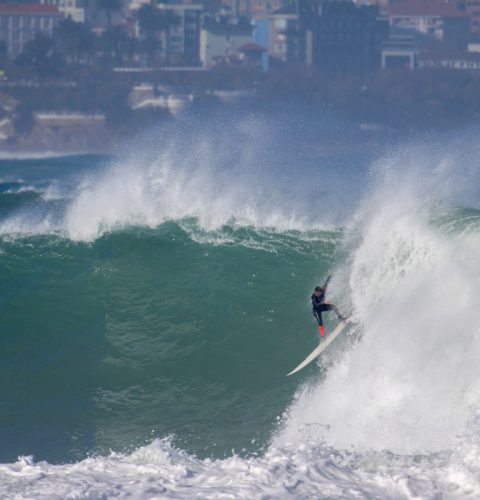“Cosa farò nel prossimo futuro? Molto probabilmente passerò molto tempo nelle aule di tribunale e forse anche in prigione. Cessare l’attività mi costerà caro. E’ possibile che riceverò multe salate. La cosa più difficile sarà tirami fuori dal caos che io stesso ho creato.
Ringrazio tutti coloro che negli anni mi hanno supportato. E’ stata una grande esperienza con persone grandiose. Ho amato questo lavoro e le persone con cui ho lavorato”
Con queste parole si conclude la lettera inviata via fax da Gordon Clark, fondatore di Clark Foam, con la quale comunica ai propri clienti e acquirenti le motivazioni che lo hanno portato a cessare improvvisamente l’attività.
Clark Foam riforniva i costruttori di tavole con un giro di 700/1000 pani al giorno. La cessazione improvvisa dell’attività ha costretto i produttori a ricercare nuove fonti di reperimento del materiale principale per la costruzione delle tavole. Il tutto è stato aggravato anche dal fatto che la notizia è arrivata come un fulmine a ciel sereno, senza nemmeno una telefonata.
Presso alcuni rivenditori di tavole della California l’evento ha comportato già un primo aumento dei prezzi delle tavole da surf limitatamente ad alcuni marchi, mentre altri hanno mantenuto invariati i prezzi di listino.
Segue il testo integrale della lettera di Mr. Clark Foam.
Testo integrale in lingua originale:
For owning and operating Clark Foam I may be looking at very large fines, civil lawsuits, and even time in prison. I will not be saying more than is in this letter so I hope you read it carefully. I do not want to be answering questions about my decisions for the next few years.
Effective immediately Clark Foam is ceasing production and sales of surfboard blanks.
I would like to give a lot more details but keep in mind that I may have both fines and criminal charges pending at this time or in the future. Therefore I have been advised by my attorney to say as little as possible. I do not want this document to be used as an admission of wrongdoing nor am i going to help the government prosecute me. I do, however, feel I owe everyone some sort of explanation- even if it is incomplete and not a full disclosure of my problems.
The short version of my explanation is that the state of California and especially Orange County where Clark Foam is located have made it very clear they no longer want manufacturers like Clark Foam in their area.
The main concern of the state and the county government is a toxic chemical we use called Toluene Di Isocynate commonly called TDI. Some of the other concerns are the use of polyester resin, dust, trash, some of the equipment I built or was built to my specifications, and numerous safety concerns both for employees and the local community.
The way the government goes after places like Clark Foam is by an accumulation of laws, regulations, and subjective decisions they are allowed to use to express their intent. Essentially they remove your security, increase your risk or liability, and increase your costs. This makes the closing of Clark Foam and similar manufacturing and accumulation of issues and not a single issue. They simply grind away until you either quit or they find methods of bringing serious charges or fines that force you to close.
Ince the main issue is TDI I will cover this first. Over the years almost all of the TDI users have left California. The government attack on TDI has been going on for decades and California was not the only state to attack its use. It was a billion pound per year chemical in the United States. In the last few years about one third of the United States TDI production capacity has been closed. I believe on of the reasons was the opening of very modern TDI plants in Asia that cost much less to build and operate. It also appears they have built a better infrastructure for handling the raw materials such as natural gas terminals and refineries.
About 20 years ago OSHA came down on our TDI use very hard and more or less tied one arm behind our back when it came to competing on the international market. We survived this and worked very hard with that agency to meet all of their requirements for using TDI. This is a federal program and in my judgment OSHA is far better managed than other agencies.
A little over 10 years ago the Orange Country Fire Authority changed their inspection methods. California also passed some new laws on TDI use. The Fire Authority also had signed up 23 cities plus the unincorporated areas of the county. They are one of the largest most powerful fire departments in the United States. They set extremely tough standards and have informally asked Clark Foam to move.
In 1999 the Federal Environmental Protection Agency copied parts of the California Law on TDI and implemented a weaker version of the California Law. California then added to the new Federal Law and their version is considerably tougher. The interpretation of this law is quite flexible and the local Fire Authority has taken a very tough line and added extra regulation that could be focused on closing Clark Foam.
Since the Fire Authority first showed an interest in TDI and today I estimate the physical changes they have required for my factory took two people less than a week to build. The cost of engineering studies, and time to satisfy their demands for our TDI processing equipment has cost in excess of $500,000. This is many times the original cost of the equipment. They are still not satisfied and continue raising new issues or go over old issues that I assumed were closed.
Another tactic used by the Fire Authority is to report us to other government agencies. This is probably a correct action on their part. For the TDI use this has become quite serious.
Based upon a complaint by the Orange County Fire Authority and information that was almost 100% supplied by the Orange County Fire Authority, the very strict Ninth District of the Federal Environmental Protection Agency (EPA) issued Clark Foam a 10-page, very serious citation. This has never been resolved. The EPA has hired a private safety engineer to pursue their citation and I believe this process is still taking place. The seriousness of their citation could mean that I could have to go to prison and be fined an astronomical amount of money. (A personal friend just paid a $4,000,000 EPA fine and barely got out of going to prison.) It is my understanding that the EPA is very slow, are difficult to deal with, and Federal Judges almost always agree with thee EPA. Essentially they refuse to directly communicate with Clark Foam.
I do not know if it was the Fire Authority’s intent but by asking for Federal help they essentially killed any chances of moving to another State.
The fire Authority has reported our TDI progress to the South Coast Air Quality Management district (AQMD) several times over the years. Each time they supply information and then they openly disagree with the AQMD findings. This tends to stir up the AQMD. The last go-around with the AQMD based on TDI cost quite a bit of money in engineering fees. (The AQMD issued us a permit for our existing equipment but the Fire Authority was not pleased with this action. Therefore, they went to the Health Department.)
The Orange County Health Department operates through the State Department of Toxic Substance Control and the State Environmental Protection Agency. In this case the Fire Authority escorted them to our premises and made their case. This is a series of hazardous waste issues both in definition and methods of disposal. This is very serious stuff and evidently subject to a lot of arbitrary interpretation.
We are emitting TDI fumes in the air.
A large part of the Fire Authority’s focus has been on TDI spills. This is very well documented. A few years ago I realized that any spill would create a massive response by the Fire Authority and I doubt they would know how to properly neutralize the spill or know when the spill was no longer emitting toxic fumes. To protect myself I purchased a $50,000,000 spill or release insurance policy with a $500,000 deductible. This was only necessary due to the current regulatory and legal environment in California. When we have gotten to this point it is a good sign that the game is almost over. (Furthermore, I doubt that $50,000,000 would do much more than pay the legal fees. Look up the 6,000 pound spill by General Chemical in California. The billed attorney’s fees were reported to be in excess of $900,000,000.)
We did our last research into new foams in 1993. What we did was, in a large part, illegal even then. Today almost any attempt at research would be very illegal due to TDI (or any isocynate) handling. The cost of required permits would be much higher than the cost of “outsourcing” or doing the work in other countries.
There are two future TDI issues. First there is a good chance that the AQMD or California will require a TDI fume “scrubber” sometime in the future. This would be a roughly 250 horsepower, giant unit costing over a million dollars. Second, there is a legislation being proposed in the state government that out TDI supplier has told us would result in them withdrawing 100% from the California market. (This has already happened with TDI storage. One supplier moved out of California in one day and was trucking in from out of state. Now they quit altogether.) If this proposed legislation passes it appears TDI will essentially be banned in California.
The above covers some of the TDI issues. Next I will move to the AQMD.
We have had AQMD permits since the 1970’s. Recently they declared the polyester resin use for the center stringers is really an adhesive and fits into different rules. One method of calculation put us into a category of a large refinery and required massive controls, permits, etc. They did some testing that substantiated some of their claims. While it appears they are wrong, they have not responded. Wo do emit over 4,000 pounds of styrene fumes per year. It appears they will call for a scrubber at some time in the future. This will cause a serious problem as we must keep fume levels within the OSHA limit. (OSHA inspects us for styrene fume levels.) Therefore, we are looking at a massive unit in the million dollar range.
When reviewing our AQMD compliance with our consultants it appears we are out of compliance in several other areas.
The next issue is ironic. When the Surfrider Foundation was just a Volkswagon Bug and a couple of guys I gave them $10,000 being the seed money to get started. Now the Surfrider foundation is a leading advocate of the storm water runoff legislation. Three agencies inspect us. We have been cited several times. While we are currently in compliance I do not believe anything but a 100% indoor facility could ever comply with what the law requires. The Surfrider foundation would have us closed down.
The Fire Authority really ripped into us over 10 years ago. We had to remove our outdoor fire sensors, have a licensed mechanical engineer certify our steel tube racks for strength, put up about 50 signs, build in rack sprinklers, add a bunch of sprinklers, and do a lot of other stuff. (This was just a few years after they forced us to quit making slab foam.) It appears the forthcoming issues could be aimed at cutting our production capacity. This is nothing new but simply an ever tightening of the screws. There is also another complete section of our processing equipment they have not addressed. So far they have only played around the edges of these issues. I read the Fire Code and they could shut us down very fast. It is a terrible feeling when one person walks in and says what you are doing is wrong. Now and then it is OK, but when an agency does it over and over you finally get the message.
The above are only some of the government agencies that inspect Clark Foam. It was put well by an expert in these areas when he said: “Ignorance of the law is no excuse – but try to find the law”.
Our official safety record as an employer is not very good. We have three ex-employees on full Workman’s Compensation disability – evidently for life. There is another claim being made by the widow of an employee who dies from cancer. According to the claim chemicals and resins at Clark Foam caused the cancer. A few years ago we had one of those horror stories one hears about lawyers. Almost $4,00,000 in lawyers fees and the ex-employee suing Clark Foam got $17,000. The Judge in the lawsuit advised me “this is just the cost of doing business (in California)”.
We have had no problems with the local city government. The Fire Authority has reported us for violations several times with no consequences. A long-range problem might be a city master plan that wants to eliminate manufacturing at our location and build offices for uses like Lawyers and Doctors. While the local city government has said nothing it appears we are also violating a number of current buildings, electrical, fire and land use codes.
There will be questions about the future of the Clark Foam manufacturing facility and equipment. I will answer them below.
Another owner or tenant cannot use the buildings without bringing them up to current code. This is impossible so the buildings will probably be torn down. There is no sense discussing the issue of permits or using the Clark Foam facility further.
In addition, you could build many blank making facilities outside the United States just for the cost of permits in California.
The equipment and process issue is based on a term frequently called “standards”. This is a difficult legal concept and will be difficult to explain. I will try my best but warn may not be accurate or correct from the point of view of a lawyer.
Hobie Alter and Dave Sweet independently showed that a polyurethane foam board was possible. Rodger Jennings, Chuck Foss, and Harold Walker pioneered the first successful blank business selling blanks directly to surfboard builders. A lot of other people were involved including myself. All of the resins, supplies, processes, and equipment were very original innovations.
Upon founding Clark Foam I began using different foam formulations, processing methods, and equipment than the other blank manufacturers. Today my plant is almost all original designs, built in house by our staff and myself. The small amount of equipment purchased outside of Clark Foam was built to my specifications or modified by me for our unique process. To sum this up no one in the United States or for that matter the rest of the world uses equipment and a process like mine. It is very unique and there was nothing on earth ever built this way before.
This is just an extension of the methods everyone used when the first foam boards were built. I continued merrily along assuming this was the way things worked. No one copied much of my process or equipment and it was very successful. I used no outside engineering firms or other experts for the majority of Clark Foam.
The Federal Environmental Protection Agency used lawyers to prepare their citation. They used the word “standards” a lot. I finally realized with shock that the EPA has determined that my equipment does not meet acceptable or accepted “standards”.
Looking back this has been the same complaint of the Fire Authority and others. They are not as articulate as the EPA lawyers and I did not understand their points. A lot of the $500,000 I spent trying to satisfy the Fire Authority was engineering studies to determine if my equipment met “standards”.
The EPA and the Fire Authority have only been interested in a small part of my equipment that handles TDI. Most of the rest of my equipment also does not meet any established “standard”.
Upon pursuing the matter with experts in the law I found that for the majority of my equipment and process I am the “standard”. This means I am legally liable for everything I designed, built, modified, or used in my unique process.
Some years ago I read that the old communist Russian tractors had a negative economic value. They were so poorly built that the raw material used to build them was worth more than the tractor that would rarely work.
I find that due to this “standards” thing my equipment and process has a negative economic value. Why sell something for a dollar when you are risking a lawsuit that could cost you anywhere from the dollar to everything you own? Since I am the “standard” I am liable for everything that was built to my “standard”. Therefore, I am not going to sell any of this equipment or the process. The liability is far too great. Furthermore, most of the equipment can be dangerous if it is not operated properly.
In closing this letter I will make several comments.
First, Clark Foam’s customers have several well known and well publicized options for making their surfboards. I will not comment on any of them nor give advice or opinion.
This letter gives a wealth of advice on isocyanate foam manufacture and some other manufacturing issues particular to Orange County or California. I do not want to clarify any of these issues further than this letter due to both pending and potential civil and criminal liability. In sum, do not bother asking me questions.
When Clark Foam was started it was a far different California. Businesses like Clark Foam were very welcome and considered the leading edge of innovation and technology. Somewhere along the way things have changed.
The State of California and Orange County California are trying very hard to make a clean, safe, and just home for their residents. This is commendable and I totally support their goals. It is my understanding their plan is to remove selective businesses to make way for new, better jobs that will be compatible with the improved environment. They are putting an incredible amount of resources into their effort. This is a tough job and they are doing a good job of meeting their goals.
The only apology I will make to customers and employees is that I should have seen this coming many years sooner and closed years ago in a slower, more predictable manner. I waited far too long, being optimistic rather than realistic. I also failed to do my homework.
What will I be doing in the near future? There is a very good chance I will spend a lot of time in courtrooms over the next few years and could go to prison. I have a tremendous cleanup expense to exit my business. I have the potential for serious fines. My full time efforts will be to extract myself from the mess that I have created for myself.
In closing I want to thank everyone for their wonderful support over the years. This has been a great ride with great people. I have loved this job and the people I worked with.
Thanks,
Gordon Clark.
Articoli correlati:
– Clark Foam chiude i battenti
Related articles











Lascia un commento